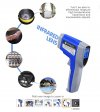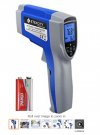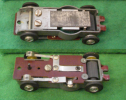All of the above. With 2 additions. If you are carrying payload, remember your ESC’s. They will be getting hotter also along with your motors. ESC failure often happens well before motor failure due to heat. Often they will cook before a motor. They haver cooling fans in a Mavic yes, but nothing like the motors under the props. ESC’s fail too. That can happen in a Mavic.
I flew 1700 miles on my
MA2 before selling it with never an issue. Next guy already added about another 150 miles no issues. With serious close inspections all the way.
These are brushless motors. So the old failure criteria is very much eliminated. They do fly a very long time. 6000-12000 rpm for 1700+ miles is a LOT of motor turns.
But you can check other things.
A.
1. Remove a prop
2. With a good handheld magnifying glass, look down into the motor housing to the core. Make sure the vinyl coated copper wiring around the poles is clean, not bubbled, not peeling, no blisters, no flakes or soot on them. Excess heat can damage those windings coatings until they short across each other, then they really burn out.
3. Magnifying glass look at the shaft bearing seats. Clean, dry, no warped seals. Not dirt caked. Hold the glass in one hand while looking, other hand gently spin and wobble the shaft to ensure zero woobble in it.
4. Magnifying glass look at the small neodymium magnets cemented out around the field. None loose or loose and magnetic stuck to a neighbor beside itself. No micro pieces of spare metals stuck to any of them. Picked up out of your bag or box or carpet or yard etc. Spare small metal frags are everywhere around people. These small powerful neodymium magnets will pick them up.
B.
See attached Pics. These are around $20 now. Any model, this is just an example of an IR thermometer gun. Walmart or any hardware has them.
Warm by hand is just that. Warm by comparison is what matters a bit more. Warm by IR read is way more accurate. One single motor may be running 20 degrees hotter than the other 3. Possibly a sign of a problem coming.
Find where the ESC’s are on your craft model. After landing, shoot an IR of the motors. Shoot an IR close to ESC’s also along the bottom heat sink and the craft body, as well as cooling ports.
104F is the top ambient flight temperature Mavic shows on my spec. sheet now. Add the sun, battery conduction heat, normal heat production, ESC heat production, plus payload extra heat production, over a few flights, and that may be reducing component life.
If you are heating your ESC’s and motors (IR reading) too hot for too long, yes they can fail.
There are some very smart electronics people on this forum. They know their science and field. They can tell you how hot your ESC or motor running temps can go for how long before they start degrading.
Add flying in hot weather already, and they may not be able to take much more heat anyway.
But these Mavics are very well built and durable craft. I have flown a 27 minute flight at 112F and landed. Hot craft but no warnings. Only did that once.
If you really want to go deep, we can discuss using a field ammeter and voltmeter around an arm of your Mavic with motors turning. High amperage from high impedance to one motor could show a problem. The onboard computer system will trip a fault at some point too high. But Mavic doesn’t publish that info. as a normal operating range. But we can calculate much of it.
Safe Flying,
KI5RLL
















